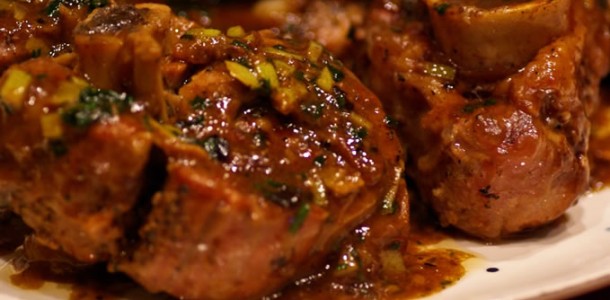- 1 sprig fresh rosemary
- 1 sprig fresh thyme
- 1 dry bay leaf
- 3 whole cloves
- 4 veal shanks
- Kosher salt and freshly ground black pepper
- All purpose flour, for dredging
- 1/2 cup bacon fat
- 3 cloves garlic, chopped
- 1 small onion, diced
- 1 stalk celery, diced
- 1 carrot, shredded
- 3 tablespoons butter
- 1 cup dry white wine
- 3 cups chicken stock
- 3 tablespoons fresh flat-leaf Italian parsley, minced
- 1 tablespoon lemon zest
- 2 cloves garlic, minced
Ossobuco – the word evokes thoughts of succulent veal, braised until the meat can be eaten with a fork alone. For the initiated, it conjures taste memories of a single bite of marrow for which there are no accurate descriptive words. In culinary terms, Ossobuco, refers to the Italian dish whose basic ingredient is veal shank, hind shank to be specific. It means hollow-bone and has been a part of Italian cooking since the 18th century where eating it has been described as “the lion of contentment” placing “a warm heavy paw” on the chest of those who have dined on Ossobuco.
Its popularity makes Ossobuco one of the most counterfeited dishes of Italian traditional cuisine in the world. To understand the flavor profile that has enjoyed such notoriety, I believe it’s important to experience Ossobuco as close to its original form as possible, including a Gremolata which is placed on top as it is served. This recipe does just that while taking into account our modern kitchens.
The true trick to all braised dishes is the very first step: carefully and comprehensively browning the pieces to a deep golden brown. This not only makes for a delicious, full-flavored piece of meat, but also contributes to a rich and complex sauce. I’ve used bacon fat instead of the fat rendered from pancetta (an Italian bacon) because of the expense and availability. Since each person is served an individual shank, look for shanks that are about a pound each. Ossobuco is traditionally served with risotto but goes well with mashed potatoes or crusty bread.
You’ll need a couple pieces of equipment: (1) A small piece of cheese cloth in which we’ll bundle our flavoring herbs so that its easily removable. This is called a bouquet garni. (2) Some cotton kitchen twine that we’ll be using for the bouquet garni and for tying the veal shanks.
Directions:
- Make a bouquet garni by placing the rosemary, thyme, bay leaf and cloves into the cheesecloth and secure with twine.
- Pat the veal shank dry with paper towels to remove any excess moisture. Veal shanks will brown better when they are dry. Then, using the kitchen twine, we’re going to need to secure the meat to the bone to keep it from falling apart when we serve. I like to wrap the twine around each shank twice and just tie it off just snug enough so its not squeezing the meat. Season each shank with salt and freshly ground pepper.
- In a large Dutch oven pot or heavy pot, over a medium-high heat bring the bacon fat to 350 degrees. You can take the guess work out of this part by dropping a few popcorn kernels in the oil. Popcorn pops at exactly 350 degrees. Dredge the shanks in flour, shaking off excess and thoroughly brown all sides. Remove browned shanks and set aside.
- Immediately add 3 cloves of chopped garlic stirring for about 45 seconds, add the onion, carrot, celery and butter. Saute until soft and translucent.
- Return browned shanks to the pan, add the white wine and reduce liquid by half. Add the bouquet garni, chicken stock and bring to a boil. Reduce heat to low, cover pan and simmer for about 2 hours turning shanks after 30 minutes. Keep the amount of cooking liquid about 3/4 the way up the shank adding water or stock as needed until the shanks are fork tender.
- Uncover the pan, remove and discard the bouquet garni and reduce the liquid by about 2/3 or until it tightens up into a thick sauce.
- Gremolata: Mix together minced parsley, lemon zest and minced garlic. When zesting the lemon, take care not to get any of the bitter pith – the white flesh right beneath the zest.
- Carefully remove the cooked shanks from the pot. Cut off the kitchen twine and discard. Spoon the sauce from the pot over the shanks, top with Gremolata and serve.





